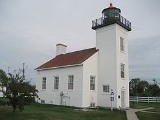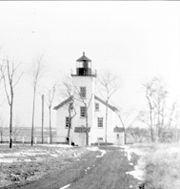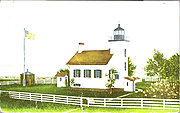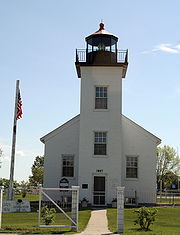
Sand Point Light
Encyclopedia
The Sand Point Lighthouse is located in Escanaba, Michigan
, United States
, on Lake Michigan
's northern shore. Since 1989, is has been an unofficial aid to navigation. Though it is an operational aid to navigation. The restored lighthouse is now open to the public during the summer months. It is also known as the Escanaba/Sand Point (Little Bay de Noc
) Light or the Escanaba Light.
This Sand Point Light is one of two bearing that name in Michigan. The other is in Baraga
.
became Escanaba's leading industry.
As shipping traffic increased dramatically, so did the need for some sort of light structure to guide the ships in and out of the harbor and to warn them of the treacherous sand shoals that reached out into Little Bay de Noc from Sand Point, a sandspit
located just south of and adjacent to the harbor area. The United States Lighthouse Service
approved construction of the Sand Point Lighthouse at a cost of $11,000. Construction began in the fall of 1867 and was completed in early spring 1868. The light first shone on the night of May 13, 1868.
 The Sand Point Lighthouse is a story-and-a-half rectangular building with an attached brick tower. The tower is topped with a cast iron
The Sand Point Lighthouse is a story-and-a-half rectangular building with an attached brick tower. The tower is topped with a cast iron
lantern room which houses a fourth order Fresnel lens
, emitting a fixed red light with a radiating power of 11.5 miles (18.5 km). A unique distinction concerning the Sand Point Lighthouse is that it was constructed with its tower facing the land instead of facing the water. Whether this orientation was intentional or an engineering blunder is unknown.
John Terry was appointed the first lighthouse keeper
of the new lighthouse in December 1867, but he became very ill and died in April 1868 a month before the lighthouse was ready to be manned. With the lighthouse nearly completed but with no lightkeeper ready to report to duty, John Terry's wife, Mary, was appointed lightkeeper and subsequently became one of the first female lightkeepers on the Great Lakes. Mary Terry was a well-respected citizen in the community and fulfilled her duties as lightkeeper with efficiency and dedication. She was lightkeeper from 1868 to 1886, when a mysterious fire severely damaged the lighthouse and took her life. To date, no one knows exactly what happened or why it happened. Some speculate that it was an attempted burglary and that the suspect set the lighthouse afire to cover any evidence of wrongdoing. The south entrance door showed signs of forced entry, yet none of Mary Terry's valuables were taken. With the lighthouse badly damaged, restoration took nearly two full months and a new lightkeeper, Lewis Rose, was appointed to take over.
Over the years a number of changes took place at the Sand Point Lighthouse. Perhaps the most significant was when the lighthouse was hooked up to the city's electric supply in 1913. This meant that the kerosene lamp was removed from within the lens and replaced with an incandescent light bulb
.
 A total of nine lightkeepers and their families lived in the Sand Point Lighthouse from its inception in 1868 to its deactivation in 1939. It was in this year that the United States Coast Guard
A total of nine lightkeepers and their families lived in the Sand Point Lighthouse from its inception in 1868 to its deactivation in 1939. It was in this year that the United States Coast Guard
took over all navigational lights in the country from the National Lighthouse Service
. The Coast Guard constructed an automated crib light several hundred feet offshore, which replaced the function and duties of the Sand Point Lighthouse and its lightkeeper. The automated crib light is still in use today and can be seen from the tower of the Sand Point Lighthouse.
The Sand Point Lighthouse was no longer operational, but it continued to serve as housing for Coast Guard seaman who were assigned to duty in Escanaba. Upon using the lighthouse as their residence, the Coast Guard made many changes to the structure. The lantern room was removed and the tower was lowered by ten feet. In addition, the roof was raised to create a full second floor, several windows were added and the entire building was covered in aluminum siding
. With these changes, the Sand Point Lighthouse was barely recognizable.
 The U.S. Coast Guard occupied the building until 1985 when they moved to a new location. The abandoned lighthouse was then obtained by the Delta County Historical Society in 1986 with plans to restore it back to its original appearance. With the help of the original 1867 plan of the building, the Delta County Historical Society began extensive research and fundraising for this immense restoration project. The historical society first removed the aluminum siding to expose the original brickwork. The roof was lowered to its original level, the new windows were bricked-in and the ten foot lopped-off tower was rebuilt. Since the original lantern room and lens were not salvaged, the historical society had to look elsewhere for replacements. They found a lantern room on nearby Poverty Island
The U.S. Coast Guard occupied the building until 1985 when they moved to a new location. The abandoned lighthouse was then obtained by the Delta County Historical Society in 1986 with plans to restore it back to its original appearance. With the help of the original 1867 plan of the building, the Delta County Historical Society began extensive research and fundraising for this immense restoration project. The historical society first removed the aluminum siding to expose the original brickwork. The roof was lowered to its original level, the new windows were bricked-in and the ten foot lopped-off tower was rebuilt. Since the original lantern room and lens were not salvaged, the historical society had to look elsewhere for replacements. They found a lantern room on nearby Poverty Island
which had been removed from the lighthouse there and was sitting on the ground next to the tower for nearly a decade. In 1989, along with the lantern room, a fourth order fresnel lens was obtained from the Menominee Pier Light
, both of which were nearly exact duplicates of the originals that once sat atop Sand Point Lighthouse and the lens was replaced.A photo of the installed Fourth Order Fresnel lens is available. To finish the restoration, the lighthouse was painted white and the interior space was restored and furnished as a turn of the century
replica.
After a dedication ceremony in July 1990, the newly restored Sand Point lighthouse was opened to the public. Each year the lighthouse is open from Memorial Day to October 1, giving visitors a chance to climb the tower and witness what it would have been like to be a lightkeeper around the turn of the century. An admission fee is charged.
The light is listed on the National Register of Historical Places, Reference #97001474.
Name of Listing: Sand Point Lighthouse. It is also on the state inventory list, beginning in 1989.
 US 2
US 2
and US 41
US 41
connect with Ludington Street. Ludington street ends at Sand Point in Ludington Park Beach, where the light is. Its address is 16 Water Plant Road, Sand Point, Ludington Park. The lighthouse is open from Memorial Day
through Labor Day
, 7 days a week, 10:00 am to 5:00 pm.
Off season tours may be arranged through the Sand Point Lighthouse, 16 Water Plant Rd, Escanaba, MI 49829, or call (906) 786-6790.
Escanaba, Michigan
Escanaba is a city in the U.S. state of Michigan, located in the banana belt on the state's Upper Peninsula. As of the 2000 census, the city population was 13,140, making it the third-largest city in the Upper Peninsula after Marquette and Sault Ste. Marie...
, United States
United States
The United States of America is a federal constitutional republic comprising fifty states and a federal district...
, on Lake Michigan
Lake Michigan
Lake Michigan is one of the five Great Lakes of North America and the only one located entirely within the United States. It is the second largest of the Great Lakes by volume and the third largest by surface area, after Lake Superior and Lake Huron...
's northern shore. Since 1989, is has been an unofficial aid to navigation. Though it is an operational aid to navigation. The restored lighthouse is now open to the public during the summer months. It is also known as the Escanaba/Sand Point (Little Bay de Noc
Little Bay de Noc
Little Bay de Noc is a bay in the Upper Peninsula of the U.S. state of Michigan. The bay opens into Lake Michigan's Green Bay.The bay, consisting of approximately 30,000 acres , is enclosed by Delta County...
) Light or the Escanaba Light.
This Sand Point Light is one of two bearing that name in Michigan. The other is in Baraga
Baraga, Michigan
Baraga is a village in Baraga County in the U.S. state of Michigan. The population was 1,285 at the 2000 census. The village is named after Bishop Frederic Baraga....
.
History
Soon after it became a town in 1863, Escanaba was quickly growing as an important shipping port. The Peninsula Railroad was completed in 1864, which linked Escanaba to the iron mines of the Upper Peninsula to the north. Iron ore docks were built in the Escanaba harbor and the shipping of iron ore to steel mills along the Great LakesGreat Lakes
The Great Lakes are a collection of freshwater lakes located in northeastern North America, on the Canada – United States border. Consisting of Lakes Superior, Michigan, Huron, Erie, and Ontario, they form the largest group of freshwater lakes on Earth by total surface, coming in second by volume...
became Escanaba's leading industry.
As shipping traffic increased dramatically, so did the need for some sort of light structure to guide the ships in and out of the harbor and to warn them of the treacherous sand shoals that reached out into Little Bay de Noc from Sand Point, a sandspit
Spit (landform)
A spit or sandspit is a deposition landform found off coasts. At one end, spits connect to land, and extend into the sea. A spit is a type of bar or beach that develops where a re-entrant occurs, such as at cove's headlands, by the process of longshore drift...
located just south of and adjacent to the harbor area. The United States Lighthouse Service
United States Lighthouse Service
The United States Lighthouse Service, also known as the Bureau of Lighthouses, was the agency of the US Federal Government that was responsible for the upkeep and maintenance of all lighthouses in the United States from the time of its creation in 1910 until 1939...
approved construction of the Sand Point Lighthouse at a cost of $11,000. Construction began in the fall of 1867 and was completed in early spring 1868. The light first shone on the night of May 13, 1868.

Cast iron
Cast iron is derived from pig iron, and while it usually refers to gray iron, it also identifies a large group of ferrous alloys which solidify with a eutectic. The color of a fractured surface can be used to identify an alloy. White cast iron is named after its white surface when fractured, due...
lantern room which houses a fourth order Fresnel lens
Fresnel lens
A Fresnel lens is a type of lens originally developed by French physicist Augustin-Jean Fresnel for lighthouses.The design allows the construction of lenses of large aperture and short focal length without the mass and volume of material that would be required by a lens of conventional design...
, emitting a fixed red light with a radiating power of 11.5 miles (18.5 km). A unique distinction concerning the Sand Point Lighthouse is that it was constructed with its tower facing the land instead of facing the water. Whether this orientation was intentional or an engineering blunder is unknown.
John Terry was appointed the first lighthouse keeper
Lighthouse keeper
A lighthouse keeper is the person responsible for tending and caring for a lighthouse, particularly the light and lens in the days when oil lamps and clockwork mechanisms were used. Keepers were needed to trim the wicks, replenish fuel, wind clockworks and perform maintenance tasks such as cleaning...
of the new lighthouse in December 1867, but he became very ill and died in April 1868 a month before the lighthouse was ready to be manned. With the lighthouse nearly completed but with no lightkeeper ready to report to duty, John Terry's wife, Mary, was appointed lightkeeper and subsequently became one of the first female lightkeepers on the Great Lakes. Mary Terry was a well-respected citizen in the community and fulfilled her duties as lightkeeper with efficiency and dedication. She was lightkeeper from 1868 to 1886, when a mysterious fire severely damaged the lighthouse and took her life. To date, no one knows exactly what happened or why it happened. Some speculate that it was an attempted burglary and that the suspect set the lighthouse afire to cover any evidence of wrongdoing. The south entrance door showed signs of forced entry, yet none of Mary Terry's valuables were taken. With the lighthouse badly damaged, restoration took nearly two full months and a new lightkeeper, Lewis Rose, was appointed to take over.
Over the years a number of changes took place at the Sand Point Lighthouse. Perhaps the most significant was when the lighthouse was hooked up to the city's electric supply in 1913. This meant that the kerosene lamp was removed from within the lens and replaced with an incandescent light bulb
Incandescent light bulb
The incandescent light bulb, incandescent lamp or incandescent light globe makes light by heating a metal filament wire to a high temperature until it glows. The hot filament is protected from air by a glass bulb that is filled with inert gas or evacuated. In a halogen lamp, a chemical process...
.
The Coast Guard years

United States Coast Guard
The United States Coast Guard is a branch of the United States Armed Forces and one of the seven U.S. uniformed services. The Coast Guard is a maritime, military, multi-mission service unique among the military branches for having a maritime law enforcement mission and a federal regulatory agency...
took over all navigational lights in the country from the National Lighthouse Service
United States Lighthouse Service
The United States Lighthouse Service, also known as the Bureau of Lighthouses, was the agency of the US Federal Government that was responsible for the upkeep and maintenance of all lighthouses in the United States from the time of its creation in 1910 until 1939...
. The Coast Guard constructed an automated crib light several hundred feet offshore, which replaced the function and duties of the Sand Point Lighthouse and its lightkeeper. The automated crib light is still in use today and can be seen from the tower of the Sand Point Lighthouse.
The Sand Point Lighthouse was no longer operational, but it continued to serve as housing for Coast Guard seaman who were assigned to duty in Escanaba. Upon using the lighthouse as their residence, the Coast Guard made many changes to the structure. The lantern room was removed and the tower was lowered by ten feet. In addition, the roof was raised to create a full second floor, several windows were added and the entire building was covered in aluminum siding
Siding
Siding is the outer covering or cladding of a house meant to shed water and protect from the effects of weather. On a building that uses siding, it may act as a key element in the aesthetic beauty of the structure and directly influence its property value....
. With these changes, the Sand Point Lighthouse was barely recognizable.
Restoration

Poverty Island
Poverty Island is a small island in the U.S. state of Michigan. The island is within Delta County in Lake Michigan and is home to an abandoned lighthouse which is in disrepair. Poverty Island is currently owned by the federal government....
which had been removed from the lighthouse there and was sitting on the ground next to the tower for nearly a decade. In 1989, along with the lantern room, a fourth order fresnel lens was obtained from the Menominee Pier Light
Menominee Pier Light
The Menominee North Pier lighthouse is located in the harbor of Menominee, Michigan. The station was established in 1877. The current structure and its still operational light was first lit in 1927, and automated in 1972. It is also sometimes called the "Menominee North Pierhead Light".The...
, both of which were nearly exact duplicates of the originals that once sat atop Sand Point Lighthouse and the lens was replaced.A photo of the installed Fourth Order Fresnel lens is available. To finish the restoration, the lighthouse was painted white and the interior space was restored and furnished as a turn of the century
Turn of the century
Turn of the century, in its broadest sense, refers to the transition from one century to another. The term is most often used to indicate a non-specific time period either before or after the beginning of a century....
replica.
After a dedication ceremony in July 1990, the newly restored Sand Point lighthouse was opened to the public. Each year the lighthouse is open from Memorial Day to October 1, giving visitors a chance to climb the tower and witness what it would have been like to be a lightkeeper around the turn of the century. An admission fee is charged.
The light is listed on the National Register of Historical Places, Reference #97001474.
Name of Listing: Sand Point Lighthouse. It is also on the state inventory list, beginning in 1989.
Getting there
 US 2
US 2U.S. Route 2
U.S. Route 2 is an east–west U.S. Highway spanning across the northern continental United States. US 2 consists of two segments connected by various roadways in southern Canada...
and
 US 41
US 41U.S. Route 41
U.S. Route 41 is a north–south United States Highway that runs from Miami, Florida to the Upper Peninsula of Michigan. Until 1949, the part in southern Florida, from Naples to Miami, was U.S...
connect with Ludington Street. Ludington street ends at Sand Point in Ludington Park Beach, where the light is. Its address is 16 Water Plant Road, Sand Point, Ludington Park. The lighthouse is open from Memorial Day
Memorial Day
Memorial Day is a United States federal holiday observed on the last Monday of May. Formerly known as Decoration Day, it originated after the American Civil War to commemorate the fallen Union soldiers of the Civil War...
through Labor Day
Labor Day
Labor Day is a United States federal holiday observed on the first Monday in September that celebrates the economic and social contributions of workers.-History:...
, 7 days a week, 10:00 am to 5:00 pm.
Off season tours may be arranged through the Sand Point Lighthouse, 16 Water Plant Rd, Escanaba, MI 49829, or call (906) 786-6790.
See also
- Lighthouses in Michigan
- Escanaba, MichiganEscanaba, MichiganEscanaba is a city in the U.S. state of Michigan, located in the banana belt on the state's Upper Peninsula. As of the 2000 census, the city population was 13,140, making it the third-largest city in the Upper Peninsula after Marquette and Sault Ste. Marie...
Specialized further reading
- Mason, Kathy S. Mystery at Sand Point Lighthouse, Michigan History Magazine, September/October 2003.
- Terry Pepper, Seeing the Light, Sand Point Lighthouse, Escanaba, Michigan.
External links
- City of Escanaba official website
- Official site of the Delta County Historical Society and Sand Point Lighthouse.
- Interactive map of Lights in Northern Lake Michigan, mapped by Google.
- Map of Michigan Lighthouse in PDF Format.
- Map of lighthouses in western Lake Michigan.
- Satellite view, Sand Point Light by Google mapsGoogle MapsGoogle Maps is a web mapping service application and technology provided by Google, free , that powers many map-based services, including the Google Maps website, Google Ride Finder, Google Transit, and maps embedded on third-party websites via the Google Maps API...
.

